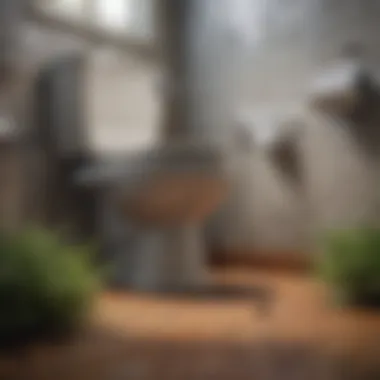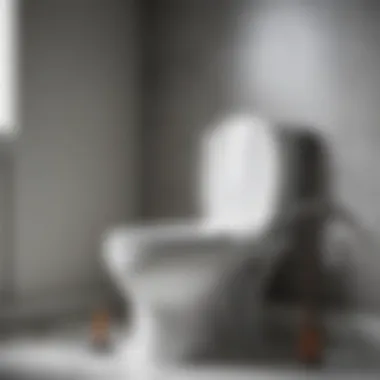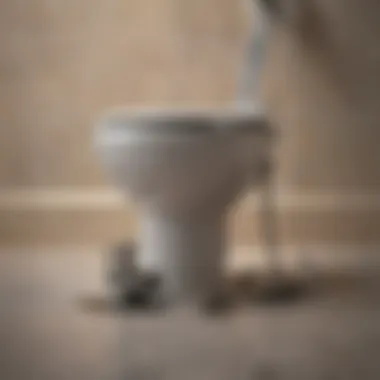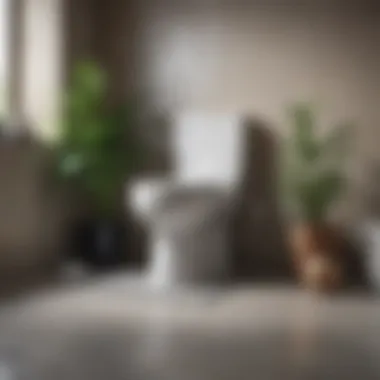Discover Effective Ways to Naturally Unclog Your Toilet Drain at Home


Toilet clogs can be a nightmare to deal with, but fret not, as nature offers us solutions that are both effective and friendly to the environment and our health. By utilizing common household items and eco-friendly remedies, you can easily tackle these pesky blockages without resorting to harsh chemicals.
Natural Drain Unclogging Methods
Baking Soda and Vinegar
One of the most popular and effective ways to unclog a toilet drain naturally is by using a simple combination of baking soda and vinegar. The fizzy reaction created by these two ingredients can help break down debris, making it easier to clear the blockage. Start by pouring a mixture of one cup of baking soda and one cup of vinegar into the toilet bowl. Let it sit for about 30 minutes before flushing with hot water.
Hot Water Flush
Sometimes, all your toilet needs is a good flush of hot water to dislodge the obstruction. Heat up a pot of water (not boiling) and carefully pour it into the toilet bowl from waist height. The force of the water combined with the heat can often be sufficient to push through the clog and get your toilet running smoothly again.
DIY Drain Snake
If the blockage is persistent, try fashioning your own drain snake using a wire coat hanger. Straighten out the hanger and create a small hook at one end. Gently insert the hooked end into the drain and maneuver it around to dislodge any accumulated debris. Be cautious not to exert too much force to avoid damaging the pipes.
Maintenance Tips for a Blockage-Free Toilet
Prevention is key when it comes to keeping your toilet drain clear. Avoid flushing items like wet wipes, feminine hygiene products, and excessive amounts of toilet paper, as these can easily cause blockages. Consider installing a drain filter to catch any potential debris before it travels down the pipes.
Understanding Toilet Drain Clogs
In the realm of plumbing, understanding the intricacies of toilet drain clogs is paramount for maintaining a smoothly functioning household. Without this knowledge, one might find oneself grappling with unexpected blockages and unpleasant surprises. By delving into the causes and signs of toilet drain clogs, individuals can equip themselves with the necessary tools to address these issues effectively and proactively.
Causes of Toilet Drain Clogs
Accumulation of Organic Waste
When it comes to the causes of toilet drain clogs, the accumulation of organic waste stands out as a prevalent culprit. Organic waste includes substances like food particles, hair, and soap scum that gradually build up in the pipes over time. This organic matter forms blockages, impeding proper water flow and leading to potential clogs in the toilet drain. While decomposable in nature, these materials can wreak havoc on a plumbing system if not managed promptly.
Foreign Objects Blockage
In the realm of plumbing mishaps, foreign objects blocking the toilet drain are a common occurrence. Often, items such as sanitary products, paper towels, and children's toys find their way into the toilet bowl, causing obstructions in the pipes. Unlike organic waste, these objects pose a more immediate risk of clogging due to their non-biodegradable nature and irregular shapes. Recognizing the risk posed by such objects is crucial for preempting blockages before they escalate.
Mineral Buildup in Pipes


Another significant contributor to toilet drain clogs is the buildup of minerals in the pipes. Over time, minerals present in the water supply, such as calcium and magnesium, can accumulate along the pipe walls. This mineral buildup constricts the passage through which water flows, leading to reduced drainage efficiency and potential blockages. Addressing this issue requires a proactive approach to prevent mineral deposits from causing long-term damage to the plumbing system.
Signs of a Clogged Toilet Drain
Slow Drainage
One of the early indicators of a clogged toilet drain is slow drainage. When water takes noticeably longer to clear from the bowl or sink, it signals a potential blockage in the pipe system. Slow drainage is often the result of partial clogs caused by the gradual accumulation of debris and waste materials. Recognizing this sign allows homeowners to intervene promptly and prevent a complete blockage from occurring.
Gurgling Sounds
Another auditory clue indicating a clogged toilet drain is the presence of gurgling sounds when flushing or draining water. These unusual noises result from air pockets trapped in the pipes due to blockages, disrupting the usual flow of wastewater. Gurgling sounds can serve as an early warning sign of impending clogs, prompting homeowners to investigate and address the issue before it escalates.
Water Backing Up
Perhaps the most alarming sign of a clogged toilet drain is water backing up into the sinks, tubs, or shower trays. This occurrence signifies a severe blockage that obstructs the normal flow of wastewater away from the property. Water backing up not only poses sanitation issues but also indicates a potentially urgent need for professional intervention to clear the blockage and restore proper drainage.
Natural Remedies for Unclogging Toilet Drains
In this article, we delve into the crucial topic of natural remedies for unclogging toilet drains. The significance of utilizing natural solutions lies in their eco-friendliness and effectiveness in tackling common toilet blockages without the use of harsh chemicals. By incorporating simple household items, individuals can successfully maintain their toilet systems while promoting sustainability within their households.
Vinegar and Baking Soda Solution
Mixing Proportions:
A fundamental aspect of the vinegar and baking soda solution is understanding the ideal mixing proportions. By combining equal parts of vinegar and baking soda, you create a powerful effervescent reaction that helps break down organic waste and clear the pipe effectively. The bubbling action helps dislodge debris and facilitates the unclogging process, making it a preferred choice for environmentally conscious individuals looking to maintain a healthy plumbing system.
Application Method:
The application method of the vinegar and baking soda solution is straightforward yet impactful. Begin by pouring the baking soda into the toilet bowl, followed by the vinegar. Allow the mixture to fizz and bubble for about 30 minutes before flushing with hot water. This method not only unclogs the drain but also deodorizes and disinfects the plumbing system, offering a holistic solution to common toilet blockages.
Hot Water Flush
Procedure for Safe Application:
When considering the hot water flush method, it is essential to follow a safe application procedure. Use water that is hot but not boiling to prevent any damage to the toilet bowl or pipes. Slowly pour the hot water into the toilet bowl from waist height to create enough force to dislodge the clog. This method is effective for minor blockages and helps maintain the proper functioning of the drainage system.
Preventive Maintenance:


Incorporating hot water flushes into your regular maintenance routine is a preventive measure that can help avoid future clogs. By flushing hot water down the toilet drain once a week, you can ensure that debris and buildup are continually cleared, reducing the likelihood of blockages and promoting the longevity of your plumbing infrastructure.
Wire Hanger Technique
Preparation Steps:
The wire hanger technique involves a few key preparation steps to effectively unclog a toilet drain. Straighten out a wire hanger and create a small hook at one end to use as a tool for dislodging the blockage. Insert the hooked end carefully into the drain and maneuver it to break apart the obstruction. This method is cost-effective and minimizes the need for harsh chemicals, making it a popular choice for individuals seeking sustainable and practical unclogging solutions.
Implementation Guidelines:
When implementing the wire hanger technique, it's crucial to handle the wire with care to avoid damaging the toilet bowl or pipes. Slowly insert the wire into the drain, gently moving it back and forth to break up the clog. Avoid using excessive force to prevent any potential harm to the plumbing system. This DIY approach is suitable for minor blockages and provides a hands-on alternative to chemical-based drain cleaners.
Preventive Measures for Maintaining Clear Toilet Drainage
To ensure a well-functioning toilet drain system, implementing preventive measures is paramount. Regularly maintaining clear toilet drainage not only prevents clogs but also promotes the longevity of your plumbing infrastructure. By incorporating preventive practices, you reduce the likelihood of encountering inconvenient blockages that disrupt your daily routine. Taking proactive steps in maintaining clear toilet drainage aligns with the theme of sustainability emphasized in this article, as it encourages responsible consumption and waste management within your household.
Regular Drain Cleaning Routine
DIY Cleaning Tips
Within the realm of DIY cleaning tips lies a fundamental aspect of toilet maintenance. These at-home techniques empower individuals to take charge of their plumbing upkeep without relying on external services. By employing DIY cleaning tips, you embrace a hands-on approach to caring for your toilet drain, fostering a sense of independence and self-sufficiency. The versatility and affordability of DIY cleaning solutions make them a popular choice for readers interested in sustainable and budget-friendly practices. While DIY cleaning tips offer convenience and control, it's crucial to be aware of their limitations and potential risks to ensure their safe and effective application.
Scheduling Frequency
Determining the optimal scheduling frequency for drain cleaning establishes a routine that aligns with your specific household needs. Consistency in cleaning intervals contributes to the overall health of your toilet drain, preventing the accumulation of debris and potential blockages. By incorporating a regular schedule for drain maintenance, you proactively address potential issues before they escalate, promoting efficient water flow and drainage within your plumbing system. The predictability and discipline of a scheduled cleaning routine enhance the reliability of your toilet drain, minimizing unexpected disruptions and optimizing its functionality.
Proper Waste Disposal Practices
Avoid Flushing Non-Biodegradable Items
An integral aspect of maintaining clear toilet drainage involves conscientious waste disposal practices. Avoiding the flushing of non-biodegradable items safeguards your plumbing system from unnecessary strain and blockages. By adhering to this practice, you uphold the integrity of your toilet drain and reduce the risk of costly repairs due to clogs caused by unsuitable materials. The emphasis on eco-conscious waste disposal resonates with the sustainable ethos of this article, promoting environmental awareness and responsible waste management within your household.
Use of Toilet Drain Filters
Incorporating toilet drain filters serves as a proactive measure to prevent debris and foreign objects from entering your plumbing system. The strategic placement of these filters offers an additional layer of protection, capturing potential clog-inducing substances before they compromise the efficiency of your toilet drain. By utilizing drain filters, you maintain a cleaner and more organized plumbing infrastructure, reducing the likelihood of blockages and promoting smoother water flow. The installation of toilet drain filters aligns with the goal of promoting sustainable practices in maintaining clear toilet drainage, highlighting the importance of preventive measures in preserving the functionality of your plumbing system.


Eco-Friendly Alternatives to Commercial Drain Cleaners
Enzyme-Based Drain Cleaners
Working Mechanism
Delving into the intricacies of enzyme-based drain cleaners, one encounters a compelling working mechanism that sets them apart from their chemical-laden counterparts. The key characteristic that defines their efficacy is the utilization of natural enzymes that target organic matter within the drainpipes. These biodegradable enzymes break down stubborn clogs by digesting accumulated debris, grease, and other waste, promoting a thorough and environmentally gentle unclogging process. The unique feature of enzymatic action lies in its ability to offer a sustainable solution without corroding the plumbing system, transforming it into a preferred choice for eco-conscious individuals seeking reliable and eco-friendly drain cleaning alternatives.
Benefits of Biodegradable Formulas
The benefits of biodegradable formulas in the realm of drain cleaning herald a new era of environmentally responsible household maintenance practices. The key characteristic of these formulas lies in their ability to decompose naturally without leaving harmful residues in the ecosystem. By opting for biodegradable drain cleaners, individuals not only clear out clogs effectively but also contribute to reducing their carbon footprint and minimizing water pollution risks. The unique feature of biodegradable formulas underscores their capacity to offer a safe and eco-conscious solution, aligning perfectly with the sustainable living ethos espoused in this article on natural toilet drain unclogging. While showcasing numerous advantages, it is important to note that biodegradable formulas may require slightly more time to show results compared to their chemical counterparts, a trade-off that eco-minded consumers willingly embrace for the greater good.
DIY Citrus Infused Vinegar Solution
Preparation Guide
Within the realm of DIY solutions for unclogging toilet drains, the citrus-infused vinegar solution emerges as a game-changer in the pursuit of eco-friendly alternatives. The key characteristic that distinguishes this preparation guide is the fusion of natural citrus extracts with vinegar, creating a potent yet gentle formula for breaking down toilet clogs. This choice resonates as beneficial and popular within the narrative of this article, emphasizing a refreshing departure from conventional harsh chemicals. The unique feature of this preparation lies in its dual action of unclogging drains while leaving behind a pleasant, citrusy scent, enhancing the overall user experience. The advantages of this DIY solution include cost-effectiveness, ease of application, and minimal environmental impact, making it a preferred choice for environmentally conscious individuals seeking sustainable toilet maintenance solutions.
Scent Neutralizing Properties
Exploring the scent neutralizing properties of the DIY citrus-infused vinegar solution unravels a nuanced approach towards eliminating unpleasant odors associated with clogged toilet drains. The key characteristic lies in the ability of citrus extracts to neutralize foul smells naturally, leaving the bathroom refreshed and inviting. This beneficial and popular feature aligns seamlessly with the overarching theme of eco-friendly toilet maintenance, offering a holistic solution that addresses both the clogging issue and its olfactory repercussions. The unique feature of scent neutralizing properties accentuates the all-encompassing nature of this DIY solution, appealing to individuals who prioritize not only functionality but also sensory aesthetics in their household cleaning routines. While showcasing several advantages in terms of odor control and environmental friendliness, it is essential to consider that the scent may dissipate over time, necessitating periodic reapplication for sustained freshness.
Professional Assistance and When to Seek Help
In the realm of toilet drain clogs, knowing when to seek professional assistance is crucial. While DIY methods are effective for routine blockages, severe cases may necessitate expert intervention. Professional plumbers possess the skills and equipment to diagnose complex issues beyond a homeowner's expertise. Their intervention ensures the problem is correctly identified and resolved, preventing recurring blockages.
Engaging professional help also offers peace of mind, as these experts can address underlying plumbing issues that DIY solutions might overlook. By entrusting the task to professionals, homeowners avoid exacerbating the problem and risking further damage to their plumbing system.
Notably, professional plumbers can provide preventive maintenance tips to mitigate future clogs. Their guidance on proper waste disposal practices and regular drain cleaning routines can help homeowners maintain clear toilet drainage over time. Seeking professional assistance proactively can save homeowners from costly repairs resulting from untreated or improperly handled clogs. When faced with persistent blockages or complex plumbing issues, consulting a professional becomes a prudent choice.
Indications for Severe Blockages
Persistent Clogs
Persistent clogs signify recurring blockages that resist conventional unclogging methods. These stubborn obstructions often point to deeper issues within the drainage system, such as significant pipe buildup or structural defects. Addressing persistent clogs promptly is crucial to prevent extensive damage to the plumbing infrastructure. While challenging to resolve independently, professional plumbers can effectively tackle persistent clogs using advanced tools and techniques. Their expertise ensures a thorough inspection of the system to identify and eliminate the root cause.
Foul Odors
Foul odors emanating from toilet drains indicate bacterial growth or decomposition within the pipes. These unpleasant smells not only signify a clog but also pose health risks to occupants. The presence of foul odors necessitates prompt attention to prevent contamination and maintain a hygienic environment. Professional plumbers can conduct detailed assessments to pinpoint the source of the odor and implement precise solutions to eliminate it. Their experience in handling such issues guarantees a comprehensive resolution that restores proper drainage and eliminates odor-causing agents.
Visible Pipe Damage
Visible pipe damage, such as cracks, leaks, or corrosion, signals a critical plumbing concern that requires immediate professional intervention. Damaged pipes compromise the efficiency and safety of the entire plumbing system, posing risks of water leakage and structural harm. Professional plumbers are trained to assess visible pipe damage accurately and recommend appropriate repair or replacement options. Addressing damaged pipes promptly not only restores the integrity of the plumbing system but also prevents potential water damage and associated expenses.



